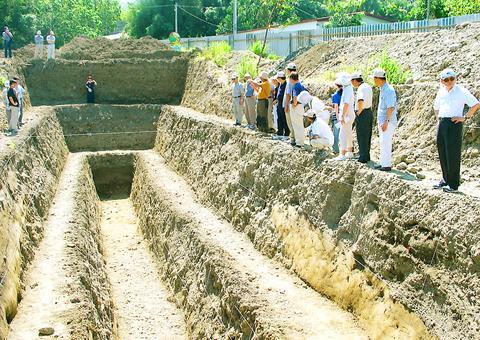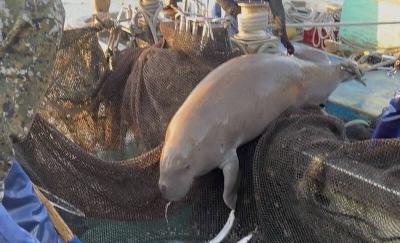Since the 921 Earthquake in 1999, scientists have thrown everything into identifying predictors of the devastating phenomenon, looking beneath the ground and even from space in a bid to improve understanding of the mechanisms responsible.
Standing beside a monitor detecting crust deformations at National Dong Hwa University in Hualien last year, National Central University geophysicist Yen Horng-yuan (
According to Yen, studies of past earthquakes suggest there is an association between the phenomenon of advance crust deformation and the onset of earthquakes.

PHOTO: CHIU YU-TZU, TAIPEI TIMES
"By carrying out continuous monitoring, we can analyze an abundant amount of data to find out where the crust begins to change before the occurrence of an earthquake. This data might be useful for research on predicting quakes," Yen said.
By the end of 2006, another 30 stations will be set up around the country to complete the GPS network, he said.
Taiwan sits atop the junction of the Philippine plate and the much larger Eurasian plate. The former is slowly being forced beneath the latter under the northern stretches of the country. The process, referred to by seismologists as subduction, is also being monitored by local geophysicists.
Since August 1998, Lee Jian-cheng (李建成), an associate research fellow at Academia Sinica's Institute of Earth Sciences, has measured crust change with creepmeters set up at Tapo Elementary School in Taitung County, which lies on the active Chihshang Fault (池上斷層).
Creepmeters measure the displacement between areas located on opposite sides of a fault.
Lee said that research suggests the Philippines and Eurasia plates are converging at a speed of 8cm per year. However, Lee's continuous monitoring of the plate suture zone in the Huatung Valley connecting Hualien and Taitung suggests that the fault has contracted between 15cm and 20cm annually over the past five years.
"We are seeing significant fault activity here. So we will continue to study how the fault interacts with others nearby in the valley," he said.
The 200km-long Chihshang Fault is only one of seven active faults to have been discovered in the Huatung Valley. In 1951, two earthquakes resulting from dramatic fault activity here ruptured the surface and changed its topography all the way from Hualien to Taitung. At some locations, the land was raised by 75cm.
To better understand these faults' behavior, National Taiwan University geosciences professor Chen Wen-shan (
"Faults in this valley are regarded by scientists as the most active in Taiwan. By analyzing layers in the trenches we can study the old earthquakes that they caused, and we might develop ideas on predicting future activity," Chen said.
Prior to the 921 Earthquake, which claimed more than 2,400 lives, most Taiwanese had grown less concerned about the occurrence of a devastating temblor.
But a number of earthquakes of similar destructive force did occur earlier last century. The 7-magnitude Meishan Earthquake in 1906 killed more than 1,250 people in the country's southwest. A 7.4-magnitude earthquake in 1935 centered in the Hsinchu-Miaoli area killed over 3,200 people; a 6.5-magnitude aftershock then killed another 2,700.
In the wake of the 921 Earthquake, which also injured more than 8,700 people and left 100,000 people homeless, the National Science Council boosted funding for earthquake-related research. Seismologists, geologists and physicists have since teamed up on innovative projects in a bid to discover signs of when the next one will strike.
Scientists have for years speculated that electromagnetic phenomena might be connected to seismic activity. Now, local physicists have decided to look to space to gather more clues.
Liu Jann-yenq (
After analyzing data of more than 300 earthquakes in Taiwan between 1994 and last year with magnitudes greater than 5, Liu found that for 70 percent of the quakes, ionospheric electron density fell sharply to around 65 percent of the normal level some time in the five days before the temblor.
Liu said that if the magnitude was 6 or higher, around 80 percent of sampled quakes had the same effect.
"We're only trying to find precursors to earthquakes. It doesn't mean we've already established a theory for a mechanism of earthquake prediction," Liu said.
However, he said, the drop in ionospheric electron density did not correlate entirely with the occurrence of earthquakes because other causes of change in electron density are known to exist.
Chen Chau-huei (陳朝輝), a seismologist at National Chung Cheng University, told the Taipei Times that local resources for seismology research remain limited. He said there were only 30 professionals delving into earthquakes.
"Actually, Taiwan can be a leading focus of seismological research because the environment in which we live is actually a natural museum for earthquakes," Chen said.

‘DENIAL DEFENSE’: The US would increase its military presence with uncrewed ships, and submarines, while boosting defense in the Indo-Pacific, a Pete Hegseth memo said The US is reorienting its military strategy to focus primarily on deterring a potential Chinese invasion of Taiwan, a memo signed by US Secretary of Defense Pete Hegseth showed. The memo also called on Taiwan to increase its defense spending. The document, known as the “Interim National Defense Strategic Guidance,” was distributed this month and detailed the national defense plans of US President Donald Trump’s administration, an article in the Washington Post said on Saturday. It outlines how the US can prepare for a potential war with China and defend itself from threats in the “near abroad,” including Greenland and the Panama

A wild live dugong was found in Taiwan for the first time in 88 years, after it was accidentally caught by a fisher’s net on Tuesday in Yilan County’s Fenniaolin (粉鳥林). This is the first sighting of the species in Taiwan since 1937, having already been considered “extinct” in the country and considered as “vulnerable” by the International Union for Conservation of Nature. A fisher surnamed Chen (陳) went to Fenniaolin to collect the fish in his netting, but instead caught a 3m long, 500kg dugong. The fisher released the animal back into the wild, not realizing it was an endangered species at

The Chinese Nationalist Party (KMT) is maintaining close ties with Beijing, the Democratic Progressive Party (DPP) said yesterday, hours after a new round of Chinese military drills in the Taiwan Strait began. Political parties in a democracy have a responsibility to be loyal to the nation and defend its sovereignty, DPP spokesman Justin Wu (吳崢) told a news conference in Taipei. His comments came hours after Beijing announced via Chinese state media that the Chinese People’s Liberation Army’s Eastern Theater Command was holding large-scale drills simulating a multi-pronged attack on Taiwan. Contrary to the KMT’s claims that it is staunchly anti-communist, KMT Deputy

The High Prosecutors’ Office yesterday withdrew an appeal against the acquittal of a former bank manager 22 years after his death, marking Taiwan’s first instance of prosecutors rendering posthumous justice to a wrongfully convicted defendant. Chu Ching-en (諸慶恩) — formerly a manager at the Taipei branch of BNP Paribas — was in 1999 accused by Weng Mao-chung (翁茂鍾), then-president of Chia Her Industrial Co, of forging a request for a fixed deposit of US$10 million by I-Hwa Industrial Co, a subsidiary of Chia Her, which was used as collateral. Chu was ruled not guilty in the first trial, but was found guilty